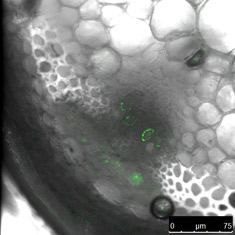What is Bioimaging?
Bioimaging relates to methods that non-invasively visualise biological processes in real time. Bioimaging aims to interfere as little as possible with life processes. Moreover, it is often used to gain information on the 3-D structure of the observed specimen from the outside, i.e. without physical interference. In a broader sense, Bioimaging also includes methods visualising biological material that has been fixed for observation.
Bioimaging spans the observation of subcellular structures and entire cells over tissues up to entire multicellular organisms. Among others, it uses light, fluorescence, electrons, ultrasound, X-ray, magnetic resonance and positrons as sources for imaging.
In cell biology, bioimaging can be used to follow cellular processes, quantify ion or metabolite levels and measure interactions of molecules live where they happen. Appropriate tracers, e.g., specific fluorochromes, and advanced microscopic instruments as e.g. confocal laser scanning microscopes (CLSM) are a prerequisite for most applications.
Recent developments in bioimaging include super-resolution, two-photon fluorescence excitation microscopy, fluorescence recovery/redistribution after photobleaching (FRAP), and fluorescence resonance energy transfer (FRET). Within the last few years a strong interaction between Molecular Biology and Bioimaging has led to the design of an increasing number of nanosensors for many ions and metabolites. When expressed or incorporated in cells, these cells become self-reporting for the metabolite in question.
Bioimages


Photos by Tonni Grube Andersen
